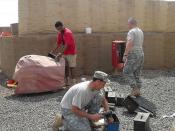Team Dynamics
The ability of a group of individuals to operate as an effective high performing team is highly contingent upon the dynamics amongst themselves. There is a broad spectrum of social relationships and interactive process dynamics which impact performance. What are the dynamics, and specifically team dynamics, that impact performance? Why are they important, and when do they evolve? The purpose of this paper is to outline how team dynamics can impact the capability of a team's members to generate a synergistic result (wherein the total result is much more than just the sum of the individual inputs).
Types of Dynamics
According to the Oxford English Dictionary, dynamics is defined as "the science dealing with motions produced by given forces" and "the forces operative in any field". Snow and Mulrooney (2002) define a real team as having a "collective task that demands a high level of interdependency among its members" (p.23).
Team dynamics are the often unseen "natural forces" (Belbin, 1984) that strongly influence how a team reacts, behaves, or performs. Suppose there is a small team of six people working in one office, and there are two people who have a particularly strong friendship. This friendship is a "natural force" that may have a dynamic influence on the rest of rest of the team, and can manifest itself in various ways, either positively or negatively. You can recognize team dynamics by looking for the forces that influence team behaviors. These behaviors can include, but are not limited to, orienting, adjusting, disagreeing, resisting, clarifying, cooperating, sharing, agreeing, solving, searching, criticizing, motivating, negotiating, initiating, and encouraging. The external forces that can impact these behaviors may include pressure to complete a task by a deadline, or within a tight budget. Internal forces may include pressure to conform to the team's view,


